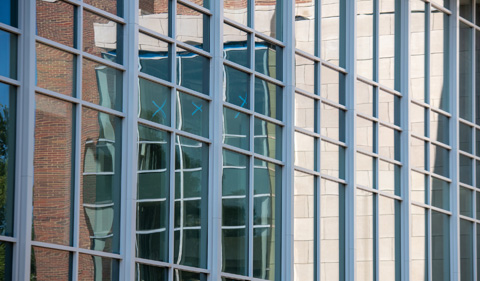
The exterior of the new chemistry building features lots of windows, limestone and brick and blends seamlessly into the campus landscape.
From Ohio University News
The Chemistry & Biochemistry Department is receiving a new mass spectrometer for its new building.
Two groups of Ohio University researchers recently received National Science Foundation grants that will bring state-of-the-art research equipment into OHIO laboratories.
“These grants are highly competitive and we are honored to receive two of them,” Vice President for Research and Creative Activity Joseph Shields said. “Both pieces of equipment will be used by a broad range of faculty and students across multiple colleges, departments and centers, and represent an important step forward in our ability to support cutting-edge research.”
The Major Research Instrumentation (MRI) grants were awarded to groups led by Russ College of Engineering and Technology Professor Wojciech Jadwisienczak and College of Arts & Sciences Professor Stephen Bergmeier. Both lead interdisciplinary groups, and Jadwisienczak is part of the Nanoscale and Quantum Phenomena Institute, and both expect researchers beyond their groups to benefit from the devices.
The team led by Bergmeier received a $315,000 grant to acquire a matrix-assisted laser desorption/ionization, time-of-flight, mass spectrometer (MALDI-TOF-MS), equipped with direct analysis in real time sources. The device will be housed in the new Chemistry Building now under construction. Mass spectrometry is one of the key analytical methods used to identify and characterize small quantities of chemical species in complex samples.
“This device will directly support 19 research-active faculty, 63 graduate students and 22 undergraduates in the Department of Chemistry & Biochemistry at Ohio University,” Bergmeier said. “In addition, this instrument will help support the research of faculty from seven other departments, institutes and centers including the Department of Biological Sciences, the Department of Environmental & Plant Biology, the Heritage College of Osteopathic Medicine, the Russ College of Engineering, the Molecular and Cellular Biology Program, the Edison Biotechnology Institute and the Nanoscale and Quantum Phenomena Institute.”
Bergmeier, a professor of Chemistry and a member of the Molecular and Cellular Biology program, is the principal investigator on the grant. Co-principal investigators are Chemistry Professor Eric Masson, Chemistry Associate Professor Justin Holub, Chemical and Biomolecular Engineering Assistant Professor Amir Farnoud, and Chemistry Assistant Professor Jessica White.
Jadwisienczak’s group received a $422,783 grant to fund a Quantum Design Physical Property Measurement System (PPMS), an automated instrument for electrical, magnetic and optical measurements on semiconductors, superconductors, organic thin films and low-dimensional materials. The PPMS supports rapidly-expanding research in the field of nanoscience, including 2D materials and flexible electronics and device engineering at OHIO.
“It’s a fundamental tool for many material and device research activities,” Electrical Engineering and Computer Science Associate Professor Jadwisienczak, the project’s principal investigator, said, adding that the closest one now is at Ohio State University in Columbus. “Having a system on campus will definitely open up the opportunity to do research faster, at our own pace.”
The PPMS, which will be housed initially in Stocker Center, and then in Russ Research Opportunity Center, has many applications that are important in materials research and development, as it will help understand materials on a microscopic level in order to improve them.
“The devil is in the details. You really need to look into the material from a nano-perspective to see where you can push the material to the extremes, and to do that effectively we need a sensitive measurement tool like PPMS,” Jadwisienczak said. Co-principal investigators on the project are Biomedical Engineering Professor Savas Kaya, Physics and Astronomy Professor Eric Stinaff, Electrical Engineering and Computer Science Associate Professor Faiz Rahman, and Chemistry Associate Professor Katherine Cimatu. All are associated with the Nanoscale Quantum Phenomena Institute.


















Comments